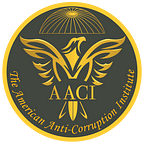When Was the Last Time You Knew Your Organization’s Corruption Exposure? — The American Anti-Corruption Institute (AACI)
Mike J. Masoud
July 25, 2022
Board members, upper management, and individuals in positions of governance play a critical role in deterring, preventing, and discovering fraud and corruption. They all play a significant part in shaping the organization’s culture, values, and norms. Furthermore, each of these decision makers is accountable for safeguarding the organization’s interests against all forms of corruption. But what should they do to satisfy their duty of care?
Competence
It is impossible to recognize something you do not know or have been trained to recognize correctly. However, the nature, amount, and scope of anti-corruption knowledge and abilities required by decision makers vary. For example, the CFO’s anti-corruption knowledge exceeds what a board member requires to fulfill his duty of care. Unfortunately, many decision-makers are unaware of two important corruption-related challenges. First and foremost, corruption is a business risk. Second, corruption occurs behind the scenes, where the damage occurs before it is discovered. As a result, people in positions of governance (the board, executive management, owner-manager, partner, minister, government, head of state, and so on) have an obligation to identify and monitor corruption risks that fall within their authority.
Corruption Exposure
It is the likelihood of corruption’s occurrence and an estimate of its magnitude during a period of time. It could occur in a business activity, process, operation, subsidiary, ministry, or economic sector because it is a business risk. It can also take many other shapes and schemes. Most importantly, corruption’s dangers are dynamic rather than static. Decision-makers should not underestimate corruption risks since the unintended effects of corruption might be disastrous. They must be aware of all business and social drivers that influence corruption risks, such as internal control, governance, rules, culture, and values.
You See What You Know
Those in positions of power cannot recognize corruption threats or convey anti-corruption policies unless they understand what corruption is and how it operates. The United States’ financial crisis of 2008–2009 teaches us a valuable lesson in this regard: when governance and risk management fail, anything is possible, including becoming a failing firm or state. So, when was the last time you inquired about your company’s vulnerability to corruption? Can you afford to be unaware of that any longer? I hope it is not too late.
Originally published at https://blog.theaaci.com on July 25, 2022.
